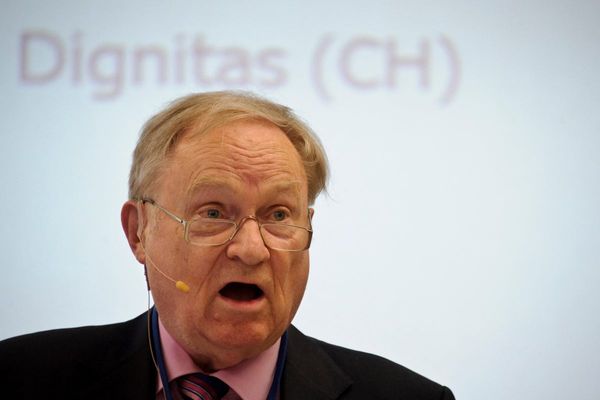
As Bruno Schulz, the Jewish writer and artist who is the subject of Benjamin Balint’s new biographical study, once wrote: “urge to sad whimpering to understand in a thousand kaleidoscopic possibilities with the feeling of homelessness”.
Well, not quite. These are Schulz’s words – sort of – but translated from the Polish in which he wrote them into English, and I’ve chosen them at random from the strange and extraordinary book Tree of Codes, produced in 2010 by the American novelist Jonathan Safran Foer. It consists of the entire text of Schulz’s short story collection The Street of Crocodiles, but with most of the words having been cut out, leaving yawning gaps, so that rather than reading the pages we read through them, creating strange, opportunistic collages of Schulz’s words, snippets and flashes of his thought.
Why would someone do this to a writer that they love? Kafka – to whom Schulz is often compared – described a book as “an ice-axe to break the frozen seas inside of us”, and Safran Foer says that “Schulz’s two books are the sharpest axes I have come across”. One difference between Kafka and Schulz is that while the former is a household name, the latter has attracted a smaller but more passionately devoted group of readers, especially among novelists who have followed in his wake: he is the quintessential writer’s writer, propping up and popping up within the fictions of Philip Roth, Cynthia Ozick, Nicole Krauss, Danilo Kiš, David Grossman, Olga Tokarczuk, and many others.
Reading Schulz’s works, it’s easy to see why he might have had such an effect on this array of creative minds. His stories defy description, explication, paraphrase. They are set in a phantasmagoric version of the city of Drohobycz (now in western Ukraine), where Schulz was born and died, and largely in and around the cloth shop on the market square that his parents owned, but in a version of these places where time and space have become molten and malleable. They take place in “years which – like a sixth, smallest toe – grow a 13th freak month” in “an illegal time… liable to all kinds of excesses and crazes”. The narrator’s father – a looming, manic, tragicomic version of Schulz’s own – at one point wastes away to nothing, leaving only “the small shroud of his body” and “a handful of nonsensical oddities”; at another he morphs into “a monstrous, hairy, steel blue horsefly”, a development that the narrator takes in his stride as just one of many “summer aberrations”. The stories read like the quintessence of the human imagination in its densest, strangest form, as if his language were a thick, sweet concentrate of the creativity that other writers dilute to a sippable weakness. The comparison with Kafka misses much of Schulz’s surreal humour and vivacity; the writer of whom he reminds me most is Maurice Sendak, with his bewitching childhood worlds filled with galumphing, unpredictable adults. Schulz’s stories provide what he called “that vibration of reality which, in metaphysical moments, we experience as the glimmer of revelation”.
In saying all of this, I am deliberately giving more space to the spaces of Schulz’s mind than to the terrible circumstances of his later life, and his death. As the Jewish community of Drohobycz was crushed into the city’s ghetto and progressively massacred, Schulz stayed alive for as long as he did by producing paintings for public buildings and for the brutal Gestapo officer Felix Landau, who wanted murals painted on his son’s bedroom walls. On 19 November 1942, the day before he was to escape with his friends’ assistance, Schulz was gunned down in the street by another Gestapo officer whose own protected Jew, a dentist, Landau had executed: “You killed my Jew,” the man supposedly explained, “I killed yours.”
Balint does a fine job of capturing Schulz’s life and his world before the war, his deeply peculiar mind and the fascinating figures in whose orbit he moved – like Debora Vogel, the multilingual poet and philosopher, author of Yiddish free verse and a PhD thesis on Hegel’s aesthetics, to whom Schulz proposed marriage before she married another man, and who deserves a biography of her own. At times he veers into unhelpful psychologising: while the analysis of Schulz’s masochistic tendencies, which are writ large in his writings, seems valid, the claim that in his encounter with Landau “the imagination of masochism… met the actuality of sadism” is to try to find meaningful symmetry in the most appalling and senseless of historical collisions.
Ultimately, however, Balint has more than just Schulz’s life and works in view, and his book begins and ends with the events from which Schulz’s contemporary reputation has become inseparable. In 2001, a German documentary film-maker rediscovered the murals that Schulz had painted for Landau, beneath the paint covering the walls of what had become a private residence. While debates about what to do with them were rumbling on, agents acting on behalf of Yad Vashem – the Holocaust Remembrance Centre in Jersualem – ripped the murals from the walls and smuggled them illegally to Jerusalem, where they remain today, triggering a major diplomatic incident and a series of debates. Who owns these works? What is their status, given that they were produced under duress – are they monuments to the cruelty of forced artistic labour or to the power of the imagination in even the worst conditions? Why should Schulz, who rejected all affiliation with organised Judaism, be claimed by a Jewish state? But given that he wrote in Polish, in a land that during his life was part of the Austro-Hungarian empire and then of Poland, why should his works belong to or in Ukraine either?

Balint explores these problems sensitively, though the book’s final sentence – which suggests that “a poetry also thrums in the longing to restore Bruno Schulz to his homeland, wherever that may be” – reads like a lyrical avoidance of the questions that he raises. I began with Safran Foer because his strange cutting out of Schulz’s words feels like a better testimony to the latter’s legacy – a reflection of its terrible gaps and absences – than the attempt to fix it in a country or in a museum. It’s no accident, I think, that Safran Foer retained the words “kaleidoscopic possibilities with the feeling of homelessness”, for this is what Schulz provides, dazzlingly and excruciatingly. No modern writer testifies more powerfully, on the one hand, to the imaginative stimulus of a particular city, and, on the other, to the absurdity of the modern nation state as a unit within which to claim and organise human lives present and past. Balint quotes Yad Vashem’s insistence that Schulz was killed as a Jew even if he did not define himself as such – but to accept this straightforwardly is to allow antisemites far too much power over their victims. I do not think that Schulz’s murals belong in Jerusalem, nor would they be at home in modern Ukraine. Render them homeless; make them mobile; move them across borders, from museum to museum, allowing as many people as possible to marvel and lament; allow them to exist as part of what Schulz called “a kind of experimenting in the unexplored regions of existence”.
• Joe Moshenska is professor of English literature at Oxford University
• Bruno Schulz: An Artist, A Murder, and the Hijacking of History by Benjamin Balint is published by WW Norton (£23.99). To support the Guardian and Observer order your copy at guardianbookshop.com. Delivery charges may apply







